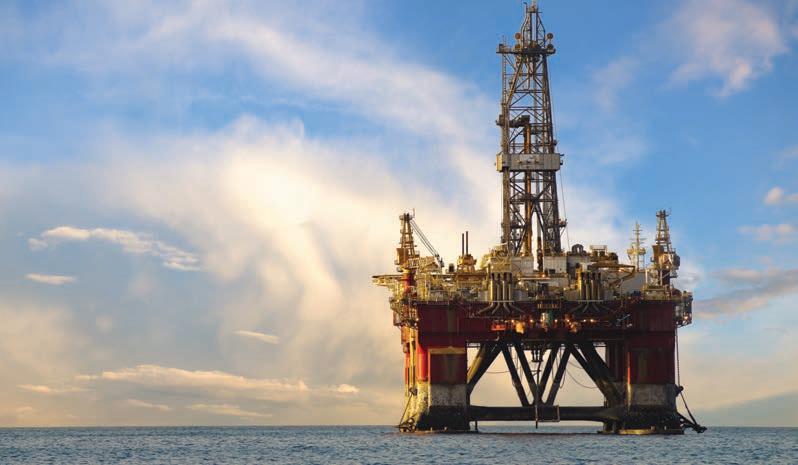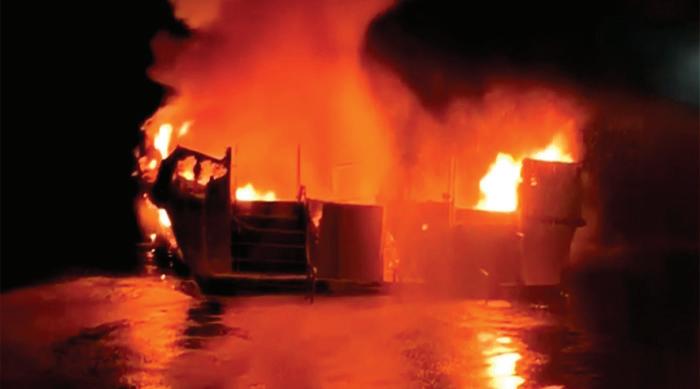REGULATIONS
New Fire Regs Advance Safety; But Challenges Remain KPIX CBS TV footage showed ferocity of fire that cost 34 lives.
I
n December, the Coast Guard released an interim rule setting new fire safety regulations for small passenger vessels (SPVs), a move taken in response to the horrific Conception dive boat disaster in Santa Barbara, Calif., in September 2019, fatal to 34. The new regs expand the circle of safety, covering firefighting training, detection and suppression systems, escape routes and electrical requirements to better ensure lithium battery safety. The Coast Guard’s timing seems fair: easier work needs to be complete in 90 days. Tasks requiring structural overhauls and drydocking get a longer timeline. The Coast Guard estimates there are 1138 SPVs. There’s a complex backstory to the new rulemaking. One starting point is a U.S. House Coast Guard and Maritime Transportation Subcommittee hearing in November 2019, two months after the Conception fire. Subcommittee members urgently demanded: what was the Coast Guard planning so that fire and entrapment like the Conception never happened again? U.S. Rep. Salud Carbajal was subcommittee chair. The Conception fire occurred in his district, and he conveyed a top subcommittee frustration: that after yet another fatal marine event the Coast Guard still had not developed an aggressive SPV safety program. In December 2019, Carbajal introduced HR 5413, a bill to “secure the safety of individuals and property on board certain small passenger vessels.” Procedurally, the text of the bill was added to other related, defense department legislation. Carbajal, who remains as subcommittee chair, was asked about the new SPV fire safety regs. Will they get the job done?
6 Marine Log // February 2022
He emphasized that, yes, the new regs advance public safety. They will prevent future accidents and they will surely improve passengers’ odds when an accident or emergency does occur. But he stressed: the job’s not finished. Carbajal seeks a safety management system (SMS) approach to fire prevention and safety. SMS is familiar in the industrial workplace. It is a dynamic concept, requiring regular assessments of processes, materials and activities to
A vessel owner is only liable for funeral and burial expenses, no matter how clearly he or she may be at fault. anticipate and prevent hazards and hazardous conditions. Again, Carbajal supports the Coast Guard’s new regs but he wants marine safety programs to evolve even further, to shift from defense to offense. Two other critical issues stand out with the new fire regs. Again, both draw context from the November 2019 hearing. When discussed today, each can provoke disbelief. One is the Limitation of Liability Act (LOLA) which limits a vessel owner’s liability to the value of the vessel and freight after an accident, unchanged since 1851! The second is the Death On the
High Seas Act (DOHSA), enacted in 1920, which limits a vessel owner’s liability for deaths of “non-seafarers” (e.g. passengers, students, vacationers) from an accident on the high seas, i.e., beyond the U.S. 3-mile territorial limit. A vessel owner is only liable for funeral and burial expenses, no matter how clearly he or she may be at fault. (The “non-seafarer” classification is critical. Crew and longshoremen are accorded different legal status.) Maritime attorney Paul Sterbcow was a panelist at the November 2019 hearing. He commented then: “My experience in the marine environment is that safety is a product of accountability, pure and simple.” His recommendation: Congress should revise DOHSA, as it did in 1996, a change that allowed victims’ survivors to seek damages after an airplane crash in the high seas. “There’s no reason to treat a plane disaster different from a boat disaster,” Sterbcow commented. Sadly, these laws mean that some vessel owners—a minority to be sure—will play the odds. If they stay lucky within three miles, that’s good. Once they transit to the high seas, where most of a vessel’s activity may take place, they know that the notion of “sovereign” does not apply. Michael Eriksen is a Florida maritime attorney who, in 2013, wrote an article in the Florida Bar Journal: “The 1920 Death on the High Seas Act: A Remedy Whose Time Has Gone.” Eriksen wryly notes the “fortuity of where a non-seafarer’s fatal injury occurs.” He writes that “DOHSA today is invoked mostly by marine tortfeasors, as a convenient escape hatch from any responsibility for the severe emotional pain and suffering their victims’ survivors almost invariably suffer.” Rep. Carbajal was asked whether Congress might need to take a closer look at these controversial statutes. In fact, in September 2021 Carbajal did introduce LOLA reform, HR 5329—“to revise laws regarding liability in certain civil actions, and for other purposes.” There has been no House action on the bill. Critically, these issues are in the ascendant, and hardly limited to the Coast Guard’s estimated 1138 vessels. Paul Sterbcow comments that offshore oil and gas industries have resisted DOHSA reform. Will the wind industry be any different, more amenable to a substantive relook at passengers who are neither crew nor longshoremen? Sterbcow said that, among attorneys, that discussion is just starting. Rep. Carbajal said such questions haven’t been taken up by legislators.
Photo Credit: KPIX CBS
By C.F. St. Clair






